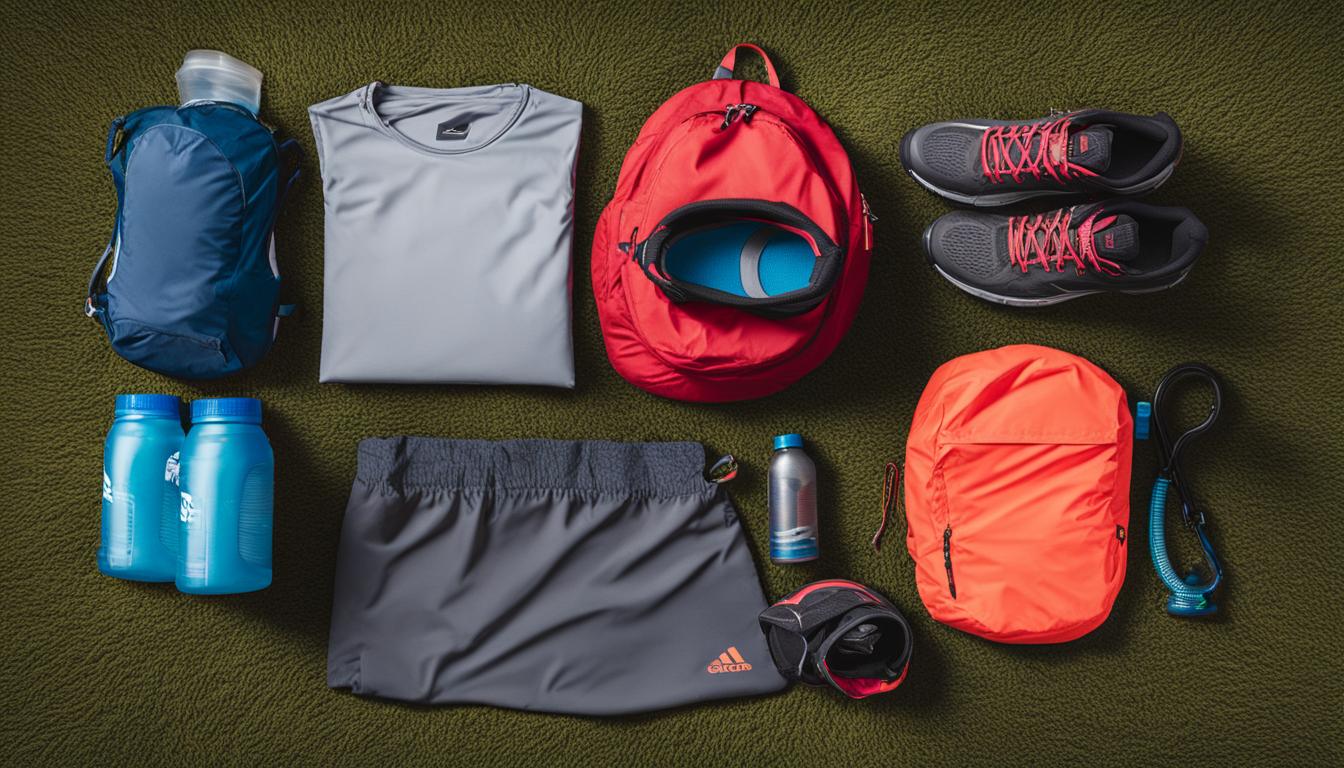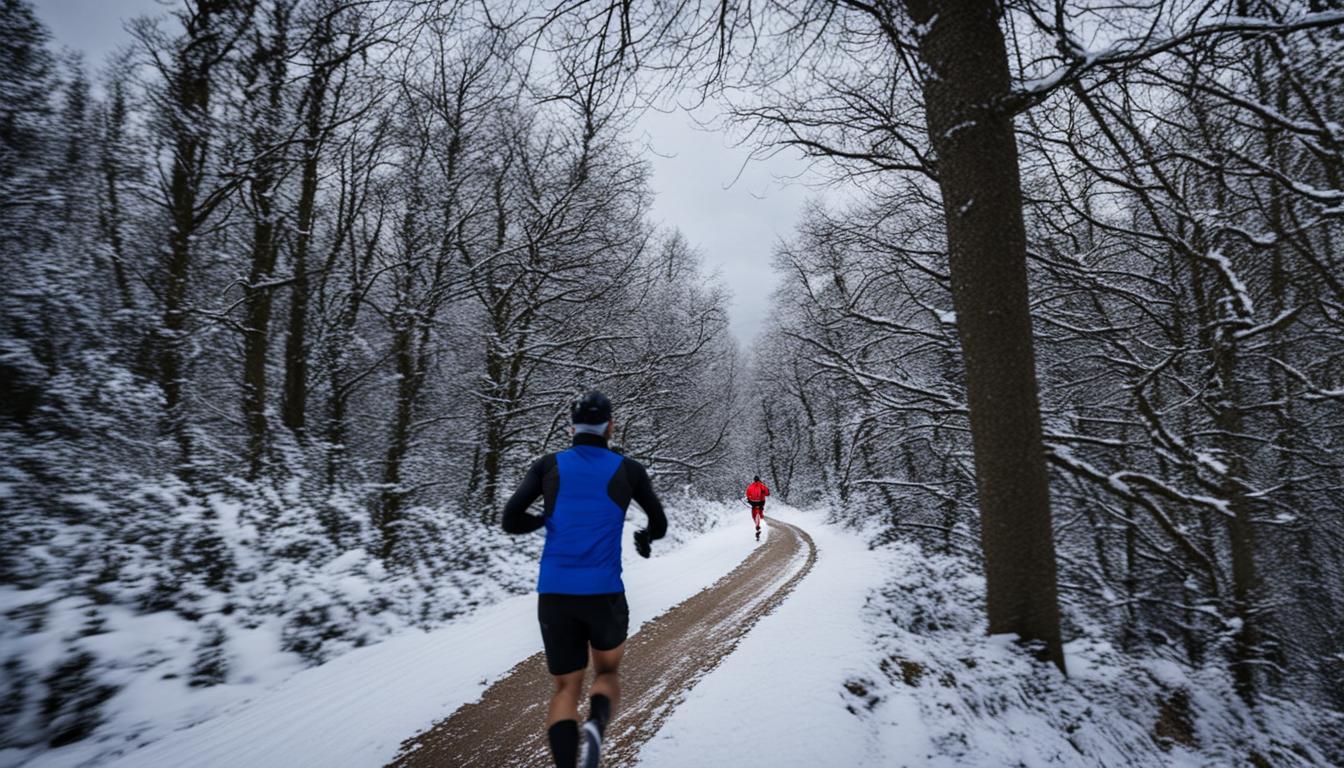Running outdoors is a fantastic way to stay active, connect with nature, and enjoy the many benefits of fresh air and beautiful scenery. Whether you’re a seasoned runner or just starting out, these outdoor running tips will help you make the most of your runs throughout the year. From finding the best running trails to choosing the right gear, we’ve got you covered.
Key Takeaways:
- Prepare for outdoor running by researching running routes and investing in the right gear.
- Stay safe during your runs by following safety tips and ensuring you are visible to others.
- Gradually increase your mileage and intensity to avoid injuries and enjoy the long-term benefits of outdoor running.
- Discover the mental and physical health advantages of running in nature and embrace the joy of exploring new routes.
- Stay motivated by setting goals, tracking your progress, and varying your workouts to keep things interesting.
Choosing the Right Running Gear for Outdoor Runs
When it comes to outdoor running, having the right gear is essential for comfort, safety, and performance.
Invest in a good pair of running shoes that provide proper support and cushioning for your feet.
Dress in layers that can be added or removed depending on the weather conditions. Consider wearing moisture-wicking and breathable fabrics to help regulate your body temperature.
Don’t forget to protect yourself from the sun with a hat, sunglasses, and sunscreen.
Additionally, accessories like a running belt, hydration pack, and reflective gear can enhance your outdoor running experience.

Finding the Best Places for Outdoor Running
One of the joys of outdoor running is exploring new routes and discovering beautiful scenery along the way. Whether you prefer running through nature trails or bustling urban paths, finding the best running routes can greatly enhance your outdoor running experience.
To discover the best routes in your area, start by doing some research. Look for scenic running trails that offer breathtaking views and a serene environment. These trails will not only provide a picturesque backdrop for your runs but also allow you to connect with nature and experience the calming effects of running in a natural setting.
If you prefer a more urban environment, consider exploring well-maintained city paths and parks. Urban running offers its own unique charm, with the energetic vibe of a bustling city and the convenience of amenities nearby. Look for popular running routes recommended by local runners, as they often know the hidden gems and scenic spots in the area.
Online resources can be a great help in finding the best running routes. Check out running forums where fellow enthusiasts share their favorite routes and provide valuable insights. Utilize running apps or GPS watches to track and map your runs, making it easy to discover new routes and keep valuable records of your progress.

Exploring new places is not only exciting but also keeps your runs interesting and motivating. So lace up your running shoes, step outside, and embark on a journey to find the best running routes that suit your preferences and goals. Whether it’s the serenity of nature or the vibrant energy of cityscapes, there’s a perfect route waiting for you.
Safety Tips for Outdoor Running
Safety should always be a top priority when enjoying the thrills of outdoor running. Whether you’re running alone, in the dark, or encountering various environmental conditions, taking precautions can help ensure a safe and enjoyable experience. Incorporate these safety tips into your outdoor running routine to stay protected:
Running Alone
When running alone, it’s crucial to let someone know your planned route and expected return time. This way, if anything unexpected happens, someone will know where to find you. It’s always better to be safe than sorry.
Running in the Dark
When running in low-light conditions or during the darker hours of the day, prioritize visibility. Make sure to wear reflective clothing that can catch the attention of others. Consider using a headlamp or carrying a light source to enhance your visibility and navigate your path safely.
Staying Visible
Being visible to others, especially motorists, is crucial for your safety. Apart from wearing reflective clothing, consider choosing running routes that have proper lighting. Running during the daytime is also advisable, as it provides better visibility and reduces the chances of accidents.
Staying Hydrated
During longer runs, it’s important to stay hydrated. Carry a water bottle or invest in a hydration pack that allows you to conveniently hydrate on the go. Remember, proper hydration can help prevent fatigue and maintain your performance.
Running Etiquette
Familiarize yourself with running etiquette to ensure a harmonious experience for yourself and other runners. Yield to pedestrians, obey traffic rules when crossing roads, and use designated running or pedestrian paths whenever possible. By practicing good running etiquette, you contribute to a safer and friendlier running environment for everyone.
By following these safety tips, you can have a worry-free outdoor running adventure. Remember, your safety is in your hands, so prioritize it at all times!

Tips for Starting Outdoor Running
If you are new to outdoor running, it’s important to start slowly and gradually increase your mileage and intensity. This will allow your body to adapt to the demands of running and reduce the risk of injury.
Begin with a beginner running program or work with a running coach to develop a training plan that suits your fitness level and goals. A well-structured plan will help you progress at a pace that is right for you, ensuring a gradual progression in your running abilities.
It’s also crucial to incorporate warm-up and cool-down exercises into your routine. A proper warm-up prepares your muscles and joints for the activity ahead, reducing the chance of strains or sprains. Similarly, a cool-down helps your body gradually recover and prevents muscle soreness.
Consistency is key when starting outdoor running. Aim to run regularly, even if it’s just for short distances at first. Establishing a routine will help you build endurance and improve your overall running ability.
Remember to listen to your body and make adjustments as needed. If something feels uncomfortable or painful, take a break or consult with a healthcare professional to prevent further injury. With time and perseverance, you’ll become a confident and accomplished runner.

Benefits of Outdoor Running
Outdoor running offers numerous physical and mental health benefits. When you run outside, you expose your body to natural sunlight, which allows it to produce vitamin D. Vitamin D is essential for bone health and helps maintain strong and healthy bones.
Running outdoors also provides significant stress relief. Being in nature and engaging in physical activity can boost your mood and reduce anxiety. The peaceful surroundings, fresh air, and the rhythmical motion of running create a sense of tranquility and well-being.
Regular outdoor running improves cardiovascular fitness and increases calorie burning, making it an effective activity for weight management. Running is a high-impact exercise that engages multiple muscle groups and elevates your heart rate. This helps strengthen your heart and lungs, enhancing your overall cardiovascular fitness.
Moreover, running outside allows you to connect with nature, enhancing the overall enjoyment of your workout. Immerse yourself in the beauty of your surroundings, appreciate the changing seasons, and embrace the serenity of the great outdoors.
By incorporating outdoor running into your fitness routine, you can reap the physical and mental rewards it offers. So, lace up your running shoes, hit the trails, and experience the incredible benefits of running in nature.
Tips for Running in Different Seasons
Running in different seasons requires adapting to changes in weather and environmental conditions. Each season brings its own challenges and considerations that can impact your running experience. By adjusting your clothing, hydration, and gear, you can continue to enjoy outdoor running throughout the year.
“The beauty of running is that you can do it regardless of the season. By adapting to the weather conditions, you can continue to pursue your passion and stay active.”
Running in Summer
When running in the summer, it’s important to dress in lightweight, breathable clothing to help regulate your body temperature. Opt for moisture-wicking fabrics that keep you dry and comfortable throughout your run. Try to schedule your runs for the cooler parts of the day, such as early morning or late evening, to avoid running in extreme heat. Don’t forget to stay hydrated by drinking plenty of water before, during, and after your run. Applying sunscreen with a high SPF is also crucial to protect your skin from the sun’s harmful rays.
Running in Winter
In winter, it’s essential to layer up with moisture-wicking and insulating clothing to stay warm. Dressing in layers allows you to adjust your clothing as your body warms up during the run. Invest in a good pair of thermal running tights or leggings to protect your legs from the cold. Consider wearing a lightweight, breathable hat or headband to retain heat while allowing moisture to escape. For added safety, use traction devices or trail shoes that provide better grip on icy or slippery surfaces. Don’t forget to cover exposed areas of your skin, such as your face and hands, with appropriate protection.
Running in Fall and Spring
In fall and spring, the fluctuating temperatures require a flexible approach. Dress in layers that can be easily adjusted as needed. Start with a moisture-wicking base layer to keep sweat away from your body. Add a lightweight, breathable mid-layer for insulation and a wind-resistant outer layer to protect against wind chill. Consider wearing a hat, gloves, and a neck gaiter or scarf to keep your extremities warm. As temperatures change throughout your run, you can remove or add layers to maintain a comfortable body temperature.
Running in different seasons allows you to experience the ever-changing beauty of nature while staying active. By adapting to the weather conditions and making necessary adjustments, you can continue to enjoy your outdoor runs year-round.

Incorporating Cross-Training into Your Outdoor Running Routine
Cross-training is a crucial element that should be incorporated into your outdoor running routine. By diversifying your workouts, you not only enhance your overall performance but also reduce the risk of injuries. Here are some key components to consider when it comes to cross-training for runners:
Strength Training for Runners
Including strength training exercises in your routine can help build muscle strength, increase endurance, and prevent imbalances. Focus on exercises that target your major muscle groups, such as squats, lunges, and deadlifts. Strengthening your lower body, core, and upper body will help improve your running form and propel you forward with each stride.
Flexibility Exercises for Improved Performance
Flexibility exercises play a vital role in enhancing running performance and preventing muscle tightness. Incorporating activities like yoga or regular stretching routines can help improve your running form, increase range of motion, and reduce the risk of injuries. By maintaining flexibility, you’ll be able to move more efficiently and maximize your running potential.
Exploring Other Activities
In addition to strength and flexibility exercises, consider incorporating other activities into your training regimen. Activities like cycling, swimming, or hiking can benefit your cardiovascular fitness while reducing the risk of overuse injuries associated with repetitive running motions. By engaging in different activities, you give your body a chance to recover while still improving your fitness level.
Remember, cross-training shouldn’t replace your running sessions but rather complement them. Aim to include at least two to three cross-training sessions per week alongside your outdoor runs. Listen to your body and gradually increase the intensity and duration of your cross-training workouts over time.
By incorporating cross-training into your outdoor running routine, you’ll be able to improve your overall strength, flexibility, and cardiovascular fitness. Take the time to diversify your workouts, and you’ll reap the benefits of injury prevention, enhanced performance, and a well-rounded approach to your fitness journey.
Tips for Maintaining Motivation in Outdoor Running
Staying motivated in outdoor running can sometimes be challenging, but with the right strategies, you can keep your enthusiasm and commitment high. Here are some tips to help you stay motivated and make the most of your outdoor running experience:
Set Realistic and Achievable Goals
Setting goals is a great way to stay motivated in outdoor running. Whether it’s running a certain distance, improving your pace, or participating in a race, setting realistic and achievable goals provides a sense of purpose and accomplishment. Break down your bigger goals into smaller milestones to track your progress and celebrate your achievements along the way.
Join Running Groups or Find a Running Buddy
Running with others can provide accountability and social support, making it easier to stay motivated. Joining a running group or finding a running buddy not only gives you an opportunity to connect with like-minded individuals but can also make your runs more enjoyable. You can share experiences, exchange tips, and motivate each other to push through when the going gets tough.
Track Your Progress
Tracking your progress is a powerful way to stay motivated in outdoor running. Use running apps or keep a training journal to record your runs, distances, times, and any other relevant data. Seeing how far you have come and the improvements you’ve made can be incredibly motivating. It also helps you identify patterns, set new goals, and adjust your training as needed.

Vary Your Workouts
Maintaining variety in your workouts can help prevent boredom and keep your motivation levels high. Include different types of runs in your training program, such as interval training, hill repeats, or tempo runs. Exploring new routes and terrains can also provide a refreshing change of scenery and add excitement to your outdoor runs. Remember, the key is to challenge yourself while still enjoying the process.
By implementing these tips, you can maintain your motivation and reap the numerous benefits of outdoor running. Remember, it’s not just about the physical aspects but also the mental and emotional rewards that come with embracing the great outdoors and pushing yourself to new limits. So lace up your shoes, set your goals, and enjoy the journey of outdoor running!
Conclusion
Outdoor running is a rewarding activity that allows you to connect with nature, improve your fitness, and enjoy the benefits of fresh air and beautiful scenery. By following these outdoor running tips for every season, you can master the art of outdoor running and make the most of your runs throughout the year.
Remember to prioritize safety by running in well-lit areas, wearing reflective gear, and being aware of your surroundings. Choosing the right gear, including comfortable running shoes and weather-appropriate clothing, will enhance your comfort and performance. Listening to your body and adjusting your pace and distance when needed is crucial for a successful and enjoyable outdoor running experience.
Whether you are a seasoned runner or just starting out, outdoor running offers a multitude of benefits for both your physical and mental well-being. So lace up your shoes, embrace the great outdoors, and start mastering the art of outdoor running. Happy trails!
FAQ
What gear do I need for outdoor running?
It is important to invest in a good pair of running shoes that provide proper support and cushioning for your feet. Dress in layers that can be added or removed depending on the weather conditions. Consider wearing moisture-wicking and breathable fabrics. Don’t forget to protect yourself from the sun with a hat, sunglasses, and sunscreen. Additionally, accessories like a running belt, hydration pack, and reflective gear can enhance your outdoor running experience.
Where can I find the best places for outdoor running?
You can research the best running routes in your area by checking out running forums, using online platforms, or using running apps or GPS watches. Look for popular routes recommended by local runners. Consider exploring scenic nature trails or well-maintained urban paths.
How can I ensure my safety while running outdoors?
If you often run alone, make sure to let someone know your route and expected return time. When running in low-light conditions or in the dark, wear reflective clothing and carry a headlamp or use a light source to ensure you are visible to others. Stay hydrated by carrying a water bottle or using hydration packs during longer runs. Familiarize yourself with running etiquette, such as yielding to pedestrians and obeying traffic rules, to ensure a safe and enjoyable running experience.
How should I start outdoor running?
If you are new to outdoor running, it’s important to start slowly and gradually increase your mileage and intensity. Begin with a beginner running program or work with a running coach to develop a training plan that suits your fitness level and goals. Incorporate warm-up and cool-down exercises into your routine to prevent injuries. Remember that consistency is key, so aim to run regularly, even if it’s just for short distances at first.
What are the benefits of outdoor running?
Running outdoors offers numerous physical and mental health benefits. Exposure to natural sunlight allows your body to produce vitamin D, which is essential for bone health. Running outdoors also provides stress relief, as being in nature and engaging in physical activity can boost mood and reduce anxiety. Regular outdoor running can improve cardiovascular fitness, increase calorie burning, and contribute to weight management. Additionally, running outside allows you to connect with nature, enhancing the overall enjoyment of your workout.
How should I adapt to different seasons while running outdoors?
In the summer, dress in lightweight, breathable clothing and run during cooler parts of the day to avoid extreme heat. Stay hydrated and apply sunscreen to protect your skin from the sun’s rays. In the winter, layer up with moisture-wicking and insulating clothing to stay warm. Consider using traction devices or trail shoes for better grip on slippery surfaces. In the fall and spring, adapt to changing temperatures by dressing in layers that can be easily adjusted as needed.
How can I incorporate cross-training into my outdoor running routine?
It is important to incorporate strength training exercises to build muscle strength and prevent imbalances. Focus on core exercises, as a strong core can improve running efficiency and reduce the risk of injuries. Flexibility exercises, such as yoga or stretching routines, can help improve running form and prevent muscle tightness. Consider adding activities like cycling, swimming, or hiking to your training regimen to improve overall fitness and reduce the risk of overuse injuries.
How can I maintain motivation in outdoor running?
To stay motivated, set realistic and achievable goals that provide a sense of purpose and accomplishment. Joining a running group or finding a running buddy can provide accountability and social support. Track your progress using running apps or a training journal to see how far you have come. Vary your workouts by incorporating interval training, hill repeats, or tempo runs to keep things interesting and challenge yourself.
What tips can you provide for mastering outdoor running in every season?
By following the tips provided in this guide, you can master outdoor running and make the most of your runs throughout the year. Remember to prioritize safety, choose the right gear, and listen to your body to ensure a successful and enjoyable outdoor running experience.


